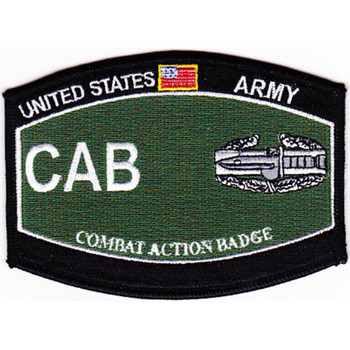Description
Armed Forces Combat Action Badge Patch 4.90" x 2.62" Embroidered Patch with Iron-On Backing
Superior Materials: Made with premium polyester thread and durable twill fabric, ensuring long-lasting color and strength.
Advanced Embroidery Technology: Crafted using the most advanced embroidery machinery, guaranteeing intricate detail, sharp lines, and consistent quality every time.
Easy Iron-On Application: Features a heat-activated adhesive backing for quick, no-sew attachment. Simply position, iron, and press for a secure bond.
Versatile Use: Perfect for personalizing jackets, backpacks, uniforms, or any fabric surface that needs a touch of personality.
Durable and Washable: Designed to withstand everyday wear and occasional washing without fading or fraying.
Formations & Origins
The Combat Action Badge (CAB) was officially approved in 2005, a relatively recent addition to the long lineage of military decorations, but born from a much older need—to recognize the bravery of soldiers who engage the enemy directly, regardless of their military occupational specialty.
Prior to the CAB, such recognition was often reserved for infantrymen through the Combat Infantry Badge (CIB). Yet, in modern warfare, cooks, drivers, signal techs, and engineers have found themselves in the thick of the fight. The CAB leveled the playing field, honoring all soldiers who faced the enemy head-on under hostile conditions.
Notable Commanders
While the CAB itself is not tied to a single unit or command, it has been championed by leaders across all Army branches who advocated for equity in recognizing combat exposure. Then-Army Chief of Staff General Peter Schoomaker helped establish the badge’s criteria, ushering in a new era of combat recognition during the height of the Iraq and Afghanistan wars.
Major Campaigns/Operations
The Combat Action Badge quickly became a symbol of valor and survival in:
-
Operation Iraqi Freedom (OIF): Where convoys, logistics hubs, and forward operating bases were regularly targeted by IEDs, mortars, and ambushes.
-
Operation Enduring Freedom (Afghanistan): Where rear-echelon roles became front-line duties in an ever-fluid battlefield.
-
Horn of Africa, Syria, and beyond: The CAB continues to honor soldiers deployed in modern conflict zones where the front line isn’t always clearly drawn.
From Baghdad to Bagram, and everywhere between, the CAB became a badge of experience—earned, not given.
Specialized Role/Equipment
The CAB is not awarded for carrying a specific weapon or holding a certain job; it’s about presence in combat and direct engagement with enemy forces. From combat engineers clearing roadside bombs to IT specialists defending a base under rocket attack, the badge covers a broad spectrum of modern combatants.
Worn above the left chest pocket, it is a subdued but powerful reminder: this soldier has seen the fight up close.
Acts of Heroism
Each CAB represents a personal story—some heroic, some harrowing. Take, for example, the story of an Army medic in Afghanistan who, while en route to a clinic, came under insurgent fire, returned suppressive fire, and saved multiple wounded soldiers despite being wounded himself. Or the transportation specialist who held the line during an ambush on Highway 1 in Iraq until reinforcements arrived.
These are not theoretical honors—they are earned in sweat, blood, and sometimes silence. Every CAB wearer has stood in harm’s way. Some received it with humility, others in memory of those who didn’t make it home.
Legacy & Notable Achievements
The Combat Action Badge is a modern emblem for a modern battlefield. It has become a symbol of the changing nature of war—one where every soldier, regardless of title, may be called to fight.
It stands as a quiet testament to grit, survivability, and the warrior spirit that lives across every role in the Army. In many cases, the CAB has helped bridge the gap between combat and support troops, fostering a deeper respect for the shared risks of deployment.
This patch honors those who didn’t choose to be in the fight—but faced it anyway. Not because it was their job, but because it was their moment. And they rose to meet it.

















